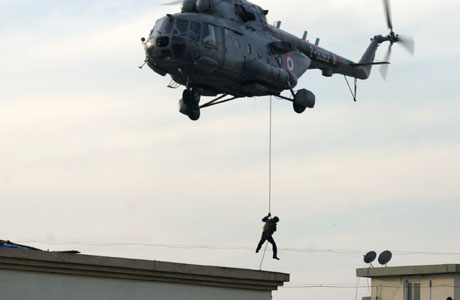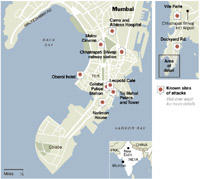|
|
|
An Indian commando rappels to assault the Jewish center in Mumbai. Reuters photograph. |
Sixty-two hours after Islamist terrorists launched a multi-pronged assault of India’s financial capital of Mumbai, Indian commandos killed the last fighter holed up in a five-star hotel and ended the siege that paralyzed the city. Indian security forces have captured a member of the assault team who has provided some details on the attack.
Indian officials have said that 195 people are currently known to have been killed and more than 300 have been wounded. Twenty-two foreigners, including five Americans, have been killed during the terror assault. The toll may rise as search teams comb through the hotels where heavy fighting occurred.
The terrorists, who are strongly suspect of being members of the Pakistan-based Lashkar-e-Taiba (the Army of the Good), began their attack on the night of Nov. 26, when one or more inflatable boats were launched from a hijacked Indian fishing vessel of the coast of Mumbai. [See Analysis: Mumbai attack differs from past terror strikes]
|
Click image to view an interactive graphic showing the attacks in Mumbai. Created by The New York Times. |
An estimated 15 to 25 terrorists fanned out throughout Mumbai and opened fire and tossed grenades at eight locations, including two hotels, a police station, a train station, a residential center, a hospital, a cinema, and a cafe. Two taxis were also blown up and a police van was hijacked and used in a shooting spree.
The initial attack overwhelmed the Mumbai police. Three senior police officials, including the head of the Anti-Terrorism Squad and two other senior officials, were killed. In all, fifteen policemen were killed in heavy fighting.
The terrorists made their last stand at the five-star Trident and Taj Mahal hotels, as well as at Nariman House, an orthodox Jewish residential center. Multiple explosions and gunfights erupted at these sites. The final battle ended this morning after Indian commandos killed the last terrorist holed up in the Taj.
Lashkar-e-Taiba operative captured
Indian security forces have captured at least one of the gunmen during the fighting, according to The Times of India. A purported Lashkar-e-Taiba operative named Ajmal Amir Kasab (or Azam Amir Kasav) was captured after being wounded in a shootout with police at the docks in southern Mumbai. Kasab and his partner Abu Ismail were responsible for killing the antiterrorism chief and two senior police officials.
Kasab, who is from Faridkot in Pakistan-occupied Kashmir, said that he and 15 other operatives from his assault team were from Pakistan and were trained by the Lashkar-e-Taiba. “All terrorists were trained in marine warfare along with the special course Daura-e-Shifa conducted by the Lashkar-e-Taiba in what at once transforms the nature of the planning from a routine terror strike and into a specialized raid by commandos,” Kasab reportedly told Indian intelligence.
Some of the operatives scouted Mumbai months prior to the attack, The Times of India reported. “[Kasab] said he had come along with eight of the operatives to Mumbai as students and lived in a rented room at Colaba market, a stone’s throw away from Nariman House.”
According to Kasab, his group departed the Pakistani port city of Karachi unarmed and linked up with the freighter MV Alpha. The assault team picked up their weapons and explosives on the freighter.
The group then ran across the Indian Fishing boat Kuber and hijacked it. The terrorists killed four crew members and kept the captain alive. He piloted the ship for one day, and then was killed. A trained seaman in Kasab’s group guided the Kubar to a point off of Mumbai. From there, the assault teams boarded two inflatable rafts and landed in southern Mumbai and began their attack.
Kasab’s team may not have acted alone, a senior US military intelligence official told The Long War Journal. “Kasab only knew about his portion of the operation, what his team did” the official said. “There appears to have been one or two eight-man teams operating on the ground.”
An Indian official told NDTV yesterday that there were 25 operatives total in the assault force. Three members of the Lashkar-e-Taiba, possibly from another cell, were reported captured yesterday. And Kasab said his group received logistical support from members on the ground. There are also unconfirmed reports that seven of the terrorists are British citizens.
Lashkar-e-Taiba and al Qaeda
Indian and US intelligence officials believe the Pakistan-based Lashkar-e-Taiba was behind the attacks. The capture of Kasab, along with signals intelligence, and a satellite phone and GPS recovered by police indicate the group was behind the attack.
The Indian Mujahideen — a front group for the Lashkar-e-Taiba, the Harkat ul Jihad al Islami, and the Students Islamic Movement of India — claimed responsibility for the attack. The Indian Mujahideen has been behind several mass-casualty terror attacks in India over the past two years.
Lashkar-e-Taiba has an extensive network in southern and Southeast Asia. A senior US military intelligence official described the group as “al Qaeda junior,” as it has vast resources, an extensive network, and is able to carry out complex attacks throughout its area of operations. “If by some stroke of luck al Qaeda collapsed, LeT (Lashkar-e-Taiba) could step in and essentially take its place.”
The relationship between al Qaeda and Lashkar-e-Taiba is complex, the official noted. “While Lashkar-e-Taiba is definitely subordinate to al Qaeda in many ways, it runs its own network and has its own command structure. The groups often train in each others’ camps, and fight side by side in Afghanistan.”
Lashkar-e-Taiba forces fought alongside al Qaeda and Taliban in the assault on the US combat outpost in Wanat in Nuristan province, Afghanistan in July of this year. Nine US troops were killed, and 15 US soldiers and four Afghan troops were wounded in the heavy fight that nearly ended in the outpost being overrun. US forces ultimately broke the attack.
Founded by Hafiz Mohammed Saeed in Afghanistan in 1990, the organization quickly expanded its reach. The Lashkar-e-Taiba has received direct support by Pakistan’s notorious Inter-Service Intelligence agency as they serve to destabilize India and wage war in Indian-occupied Kashmir.
Like al Qaeda, the Lashkar-e-Taiba seeks to establish a Muslim caliphate in southern and central Asia. Lashkar-e-Taiba “consistently advocated the use of force and vowed that it would plant the ‘flag of Islam’ in Washington, Tel Aviv and New Delhi,” the Southeast Asia Terrorism Portal reported. Also, like al Qaeda, Lashkar-e-Taiba practices Wahabism, the radical Islamist school of thought born in Saudi Arabia.
The group essential runs a state within a state of Pakistan. The sprawling Muridke complex houses “a Madrassa (seminary), a hospital, a market, a large residential area for ‘scholars’ and faculty members, a fish farm and agricultural tracts. The LeT also reportedly operates 16 Islamic institutions, 135 secondary schools, an ambulance service, mobile clinics, blood banks and several seminaries across Pakistan.”
The US government designated Lashkar-e-Taiba as a Foreign Terrorist Organization in December 2001. The Pakistani government banned the group in January 2002, but this did little to shut down its operations. The group renamed itself the Jamaat-ud-Dawa and conducted business as usual.
The Pakistani government has arrested Saeed several times of the past six years after major terror attacks in the region. Saeed is “placed under house arrest inside Muridke,” a US intelligence official told The Long War Journal. He is “released” after the controversy over the attack dies down,” the official said sarcastically.
“Since the Sept. 11 attacks, the Pakistani government has shown no desire to shut down Lashkar-e-Taiba, despite the fact the group is operating in the open,” the official noted. “They are a state within a state, backed by the state’s intelligence service,” the official said, referring to Pakistan’s Inter-Service Intelligence agency. “Right now, they are untouchable.”
For more information on the Mumbai attacks, see:
• Analysis: Mumbai attack differs from past terror strikes
November 28, 2008
• India’s financial capital under terror siege
November 26, 2008










8 Comments
As always, great report!
Is it true that Pakistan is pulling troops off of the Afghan border? If so, its mission accomplished for AQ?
If the Mumbai attack was really intended to free hostages, then quick action by the Indians has disrupted the attack.
If the attack was intended to change the outcome of the Kashmir conflict, then the attack has failed.
If the attack was intended to hurt Britain, the US, or Israel, the attack has failed.
If the attack was intended to retaliate for actions in Afghanistan, then it’s success is limited.
But if the attack was intended to worsen Indian-Pakistani relations, there might indeed have been some success.
And whether the attack strengthens or weakens the ISI within Pakistan, I cannot tell.
Clearly, India may help bring the fight to Waziristan.
“Clearly, India may help bring the fight to Waziristan.”
Oh dear God, I hope so.
time to go in hard and fast..
I can only pray
Good job clarifying for those that are more conspiracy prone that LeT and AQ share an ideological overlap, with some operational links, but overall represent two seperate networks spawned from different political conflicts.
The disagreement within the intelligence community as to the status of AQ vs franchise cells has clouded who and what is al-Qaeda vs just “AQesque”.
The Pakistan connection here is strong – but there needs to be caution to not overplay it. New Delhi is most likely eager to pass the buck to absolve Indian involvement and the state’s own security failures. India does not make a good critic. Pakistani govt. relationship with LeT is a serious problem – India pushing them to do something about it may be worse…for all of us.
Fred & Jordan have got it just right. Karzai is well disposed toward India and Indian road building crews are now helping the Afghans. It’s time for India to join the coalition in Afghanistan. Their mountain troops should be great for training the Afghan army along the tribal border, even joining with them, and NATO, and local tribes, in taking over tribal areas most remote from the Pak writ. These areas can then be given to the Paks whenever they are able to hold them securely. Kashmiri terrorists are even now transferring to the tribal areas to fight along side AQ and the Talibs there, thus taking the pressure off India in Kashmir, a win-win set up for finally defeating the mass-murdering terrorists.
Fred may be right that this could intensify calls for action in NWFP…but Jordan and Jean are just wrong. Indian forces in Pakistan?! Not only is it impossible…its apocalyptic. If you think partition-era violence was horrific, see what happens if you insert indian troops in Pakistani territory….I wonder what effect fallout has on global warming.
I’ve always been suspicious of the claims that rogue elements in the ISI are what is behind most of its nefarious activities. I’m more inclined towards this point of view.
Powerline: Thinking about Mumbai: India’s test, part 2
If you can accept that point of view, then if the premise of this article is correct, Pakistan continues to play a double game.
Times of India: Foreign SIM cards, fake IDs from Bangladesh
Trey,
“Indian forces in Pakistan?!”
Perhaps your right, that would be bad.
But what if Pakistan and India worked together to
flush the swamp?
Call me a dreamer